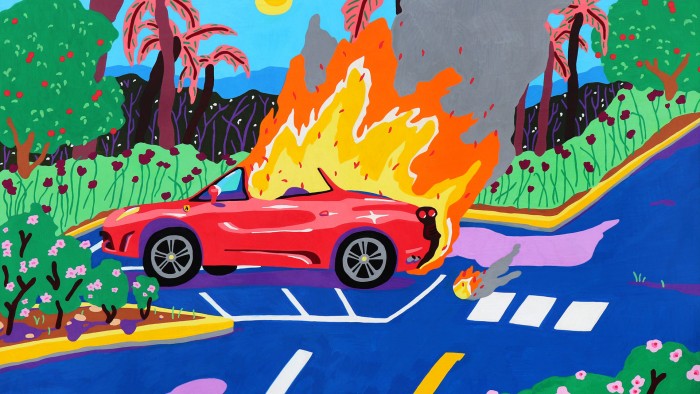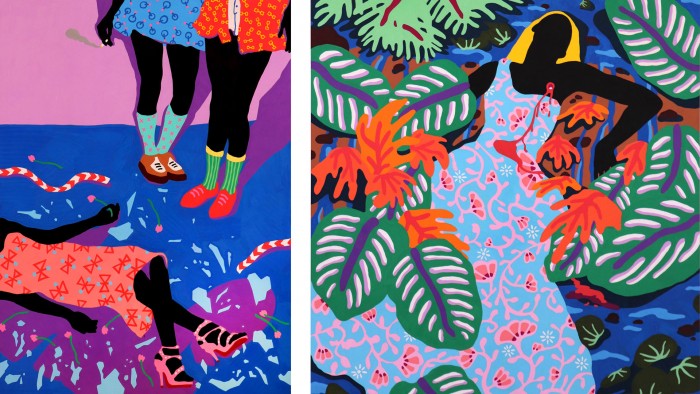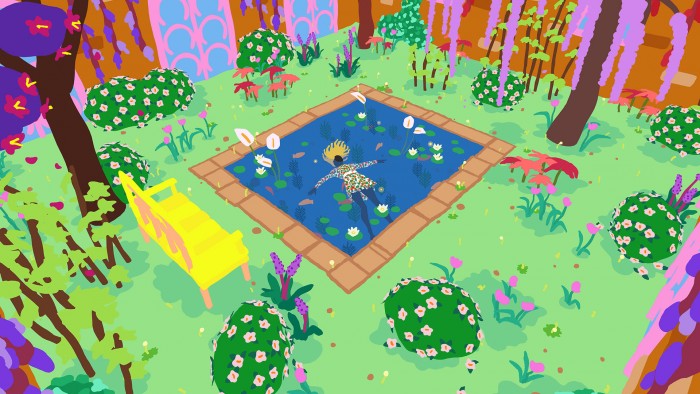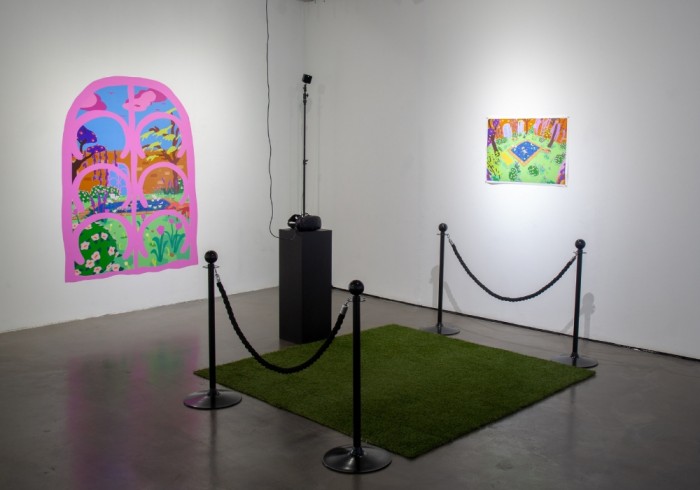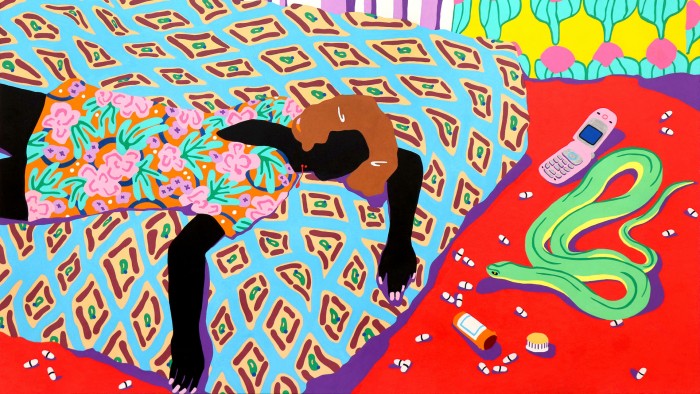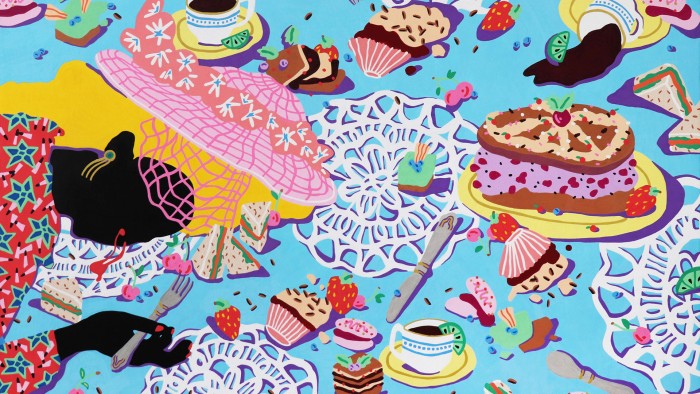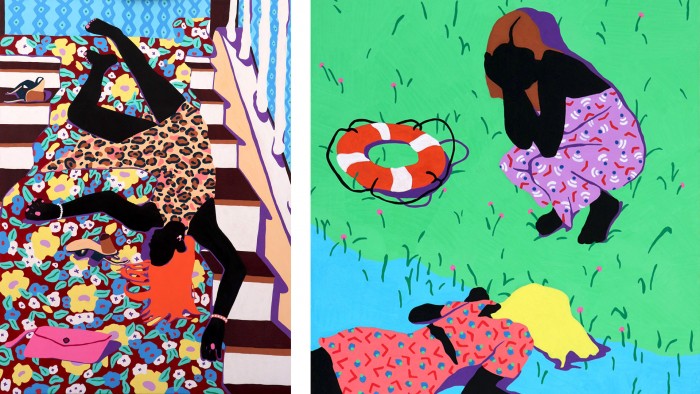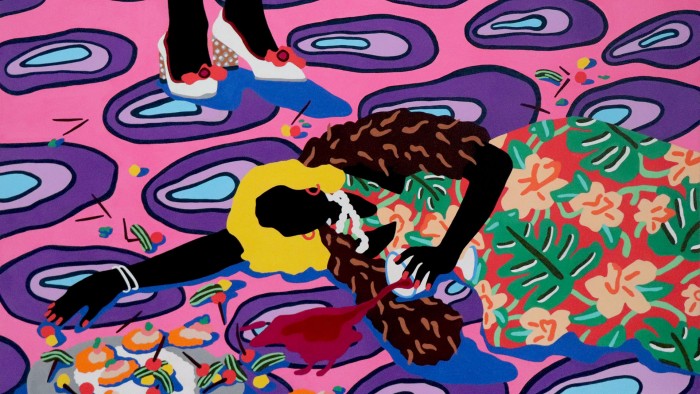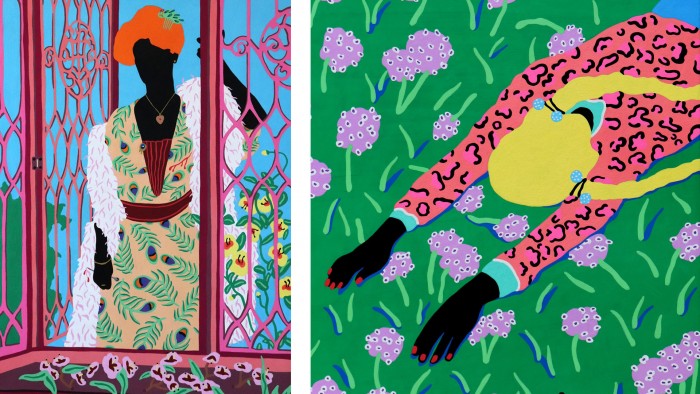Artists are world-builders. Whether borrowing from existing architecture or imagining new landscapes, they have to set the scene in which their narratives play out. South African artist Olivié Keck’s worlds are saturated with psychedelic colour and pattern; seeping with hot bright ink from her Copic Markers.
As still images they vibrate with energy, but by means of virtual reality she’s really bringing them to life.
Keck’s first experience of VR was with Tilt Brush by Google. While you wear a headset, the programme enables you to paint in 3D space using handheld controllers. The room around you becoming your canvas. Different brushes and effects can be chosen to express your creativity.
“I found the experience completely liberating and other-worldly,” she says. “It was something of which I wanted to be a part. I had a feeling the medium would ‘wow’ art audiences, and I wanted to see where I could take the medium with my own aesthetic ‘flavour’.”
‘Drop Dead Gorgeous’ is Keck’s solo show currently on at the Circa gallery in Johannesburg. The works interrogate society’s morbid fascination with crimes of passion as entertainment.
In them, her fashionable victims lie face down in a swimming pool at a party or fallen to the floor having taken down a tray of fancy canapés and a glass of merlot on the way down. Their glamorous attire and dramatically posed bodies create a sheen that distracts from the tragic events.
"The works embody a playful parody rooted in a more serious questioning of our cultural obsession with depictions of violence and the romanticism of crime as entertainment", reads the artist statement.
Keck’s most recent VR piece, ‘Ophelia Forever’ is an extension of this series. The victim is William Shakespeare’s Ophelia who, driven mad with grief and betrayal, drowned herself in a river.
Keck joins a legion of artists who have depicted the heroine, most famous of which is John Everett Millais whose painting ‘Ophelia’ was completed in 1852. In Keck’s version she immortalises the scene from ‘Hamlet’ in pixels instead of paint. The classic depiction is given a contemporary, high-tech twist. Instead of viewing the artwork on the gallery wall, it exists only in the 3D realm to which you’re transported by putting on VR goggles and headphones. The effect is as if you’ve stepped inside the artwork, surrounded by Keck’s colours in every direction in which you look. You are a voyeur and before you, the lifeless body of Ophelia lies suspended in a koi pond. Looking to your right and left it appears that you’re standing in a beautiful courtyard, looking up at pink clouds floating in a pale blue sky, while birds chirp between sweeping ambient sounds.
Expanding Keck’s 2D works into all-encompassing environments means considering unfamiliar elements to a painter such as motion and sound. To create the world in ‘Ophelia Forever’, she collaborated with programmer Evan Greenwood and sound designer Jason Sutherland.
She compares the collaborative process of working in VR to creating a film. As the art director, Keck has to consider the multiple perspectives that the scene will be viewed from; she can’t predict where a viewer might place their gaze.
She always starts by drawing an imagined landscape by hand, “a kind of mood board for the feeling of the scene,” she says. “There are a lot of unforeseen complexities when you are taking a single drawn perspective into a panoramic environment which people can explore from multiple viewpoints.”
Modelling the scene in 3D and creating the layout in the game engine is the most time-consuming part of the project. Greenwood animates the scene giving physics and movement to the objects in it, and the environment comes alive.
“How things move, and how that movement feels to the player is important,” Keck says. “It’s very easy to make people feel nauseous in VR, so you want to try and avoid changes in velocity or rocking motions or sudden drop-offs.”
Lastly, sound is layered into the world. Sutherland employs techniques such as directional sound and attenuating sound to create a dense soundscape. “The sound needs to echo the feeling of the world and bring home the mood of the experience,” Keck adds. “It might not be visible to people, but it’s such a crucial component in the overall impact.”
In ‘Ophelia Forever’, the calming sounds in the experience strike a mood that’s purposefully at odds with the tragic scene with which you are faced.
“I think I want people to be struck by conflicting emotions when they view the piece,” Keck says. “We’ve gone to great lengths to make the scene feel both peaceful and ominous. The saturated colours and the movement of the world almost feels whimsical and playful, Disney-fied you could say; however the tranquil drowned body floating in the pond takes the atmosphere to a more sinister place than the initial colourful window-dressing.”
Keck enjoys this juxtaposition. “I want the viewer to think; “I feel strangely complicit in a horrific event though I’m struck by the beauty and romance of the scene at the same time”. I think being human is about fluctuating between dualities. I think that's happening to us in real life all the time. I just like to turn up the dial and take it a bit further. “If in doubt, say it loud” is my motto with art-making.”
Certain qualities of Keck’s hand drawn style - the flat, saturated colour, the simple shapes and the lack of tonal gradient - lend themselves effortlessly to digital renders. And even before she considered experimenting with VR, her colour-charged worlds begged for further investigation.
“I think the atmosphere [in my work] feels dreamy, curious and fun, and people feel the desire to explore,” she comments. “There’s a fantastic playfulness about the world(s) that encourages exploration and maybe captures a nostalgia that I loved about old quest games. There is this sense that the world is artificial, like a stage, yet it also feels limitless, like a ‘real’ space that has meaning and significance.”
VR has the potential to make an artist’s world more potent; the feeling they’re trying to convey more experiential.
“I think bringing tech into the art space is inevitable, as art always hankers after innovation and newness,” Keck says. “I believe art is increasingly about creating a novel experience that immerses people. VR can provide a great spectacle for a visual idea. I think that's what a younger art audience is excited by.”
To enhance the voyeurism of ‘Ophelia Forever’, Keck decided to omit handheld controllers from the experience, meaning viewers can’t interact with the work beyond walking around within it. But the potential is huge for viewers to play a more active role within these scapes; imagine picking up a virtual object to inspect it more closely, or changing the scenery entirely with a gesture. In these worlds collaboration can go further than that of their makers to include the audience.
While we look forward to art’s immersive future, until the technology becomes more accessible, the medium is not necessarily inclusive. But before something becomes widely adopted, it takes pioneers to take the first steps into uncharted territory, in this case an extra dimension.
“Perhaps if VR becomes a more familiar language of expression, more people will be encouraged to explore art within it,” Keck says.
The curiosity of artists like her is a driving force for new experiences. Being ahead of the curve means it may take a while for art collectors and investors to catch up.
More on the intersection of art and tech
Tea Uglow on the creative unknown and dispelling misplaces confidence in reality
Zach Lieberman on using human gestures to bring his work to life

